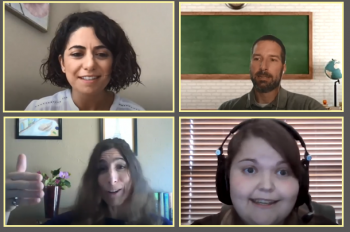

For all of us the COVID global pandemic has thrown a wrench into our daily lives. For many of you this disruption impacted your teaching, a vitally important segment to the well-being of institutions of higher learning. As teachers it might have seemed like you were catapulted into teaching in unfamiliar territory!
How do you make the best of this situation? How can you bring the most value to your new teaching requirements?
And, with all the technologies available today – where does one start!?
On Thursday, August 27th the NISS Affiliates committee brought together three experts in teaching statistics online to provide their advice, strategies, methods and a review of helpful technologies.
John Haubrick (Penn State University) began the session. John has taught in just about every circumstance face-to-face, hybrid and online. He has taught small classes and right now is teaching a class of 300. Based on this wide range of experience, John referenced educational theories related to transactional distance and community of inquiry as he shared ideas for how to handle the challenges of teaching large courses online. His analogy highlighting the difference between using a compass or a GPS system to find your way was indicative of his approach. He emphasized the importance of being very intentional and working to provide explicit step-by-step directions as a means of saving time and energy as you lead a class. John offered some practical ideas and tools to use to help make the large class feel smaller by “being present” and “making thinking visible”.
Kristin Lynn Sainani (Stanford University) is also no stranger to teaching. After walking the audience through the instructional technologies that she has seen pass through her classroom (starting with overhead projectors and slide trays!), Kristin described her range of classroom experience including creating Massive Open Online Courses (MOOCs) and teaching writing and intro and advanced stats courses, both in-class and remote, many of these using a “flipped” approach. She got down to specifics right away providing a variety of tips. These include: tips for pre-recorded lectures, tips for synchronous remote lectures, tips for conducting active learning exercises remotely, and tips for online assignments and exams. If you are looking for ideas and suggestions you can use tomorrow, Kristin provides a ton of these!
Melinda Clardy (South Louisiana Community College) focused on a topic that troubles teachers across disciplines, academic integrity. Melinda demonstrated very succinctly how, because of the immediate availability of access to answers to problems on the web (Mathway, PhotoMath, Chegg, CourseHero, …), how important this is for teachers of math and statistics. After describing the advantages of free response test questions as an approach, Melinda acknowledged that this is not always feasible when teaching statistics and so, provided alternative approaches that instructors can employ including randomization (on many levels), mastery learning and completion-based grading approaches. In addition, Melinda shared her observation that developing a strong relationship with her students was an important factor in whether her students made poor decisions when completing assignments.
If you are in the process of planning your classes, remotely, mixed-mode or even “mask-to-mask” – this is a session that you will not want to miss!
Recording of the Session and Slides Used by the Speakers
John Haubrick (Penn State University)
"Leverage technology to make large online classes feel small"
Kristin Lynn Sainani (Stanford University)
"Making the jump to online and remote teaching: tips and tools"
Melinda Clardy (South Louisiana Community College)
Links to Resources Mentioned Related to Teaching Online
We thought it would be a good idea to provide a list of direct links to the many great resources or informational sites that were mentioned in the talks above.
Tools for Video Production:
Camtasia, https://www.techsmith.com/video-editor.html
iSpring Suite, https://www.ispringsolutions.com/ispring-suite
Powtoon, https://www.powtoon.com/
Biteable, https://biteable.com/
Rawshorts, https://www.rawshorts.com/
Adobe Spark, https://spark.adobe.com/
Do-it-yourself lightboard: https://www.youtube.com/watch?v=L1au1JxMSaA
Kaltura, https://corp.kaltura.com/
Tools for Interactive Exercises:
Mentimeter, https://www.mentimeter.com/
Google docs, https://docs.google.com/
Poll Everywhere, https://www.polleverywhere.com/
Padlet, https://padlet.com/
Whiteboard Fox, https://whiteboardfox.com/
A Web Whiteboard, https://awwapp.com/
Google jamboard, https://edu.google.com/products/jamboard/
Annotate (in Zoom), https://zoom.us/
Piazza, https://piazza.com/
Sites related to Academic Integrity:
Chegg, https://www.chegg.com/
Chegg Copyright page, https://www.chegg.com/copyright
CourseHero, https://www.coursehero.com/
PhotoMath, https://photomath.app/
Mathway, https://www.mathway.com/
